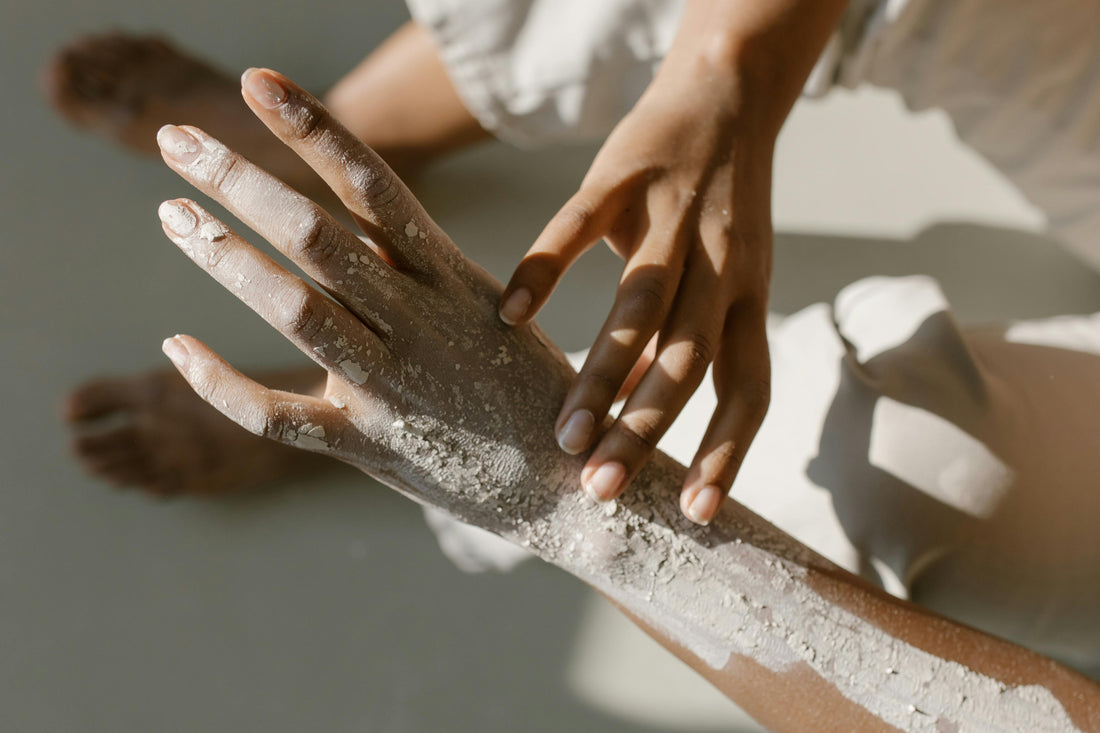
Hammam at Home: Mineral-Rich Clay Body Mask
Share
The hammam tradition is a cleansing and renewal ritual that combines exfoliation, clay, and oils to leave the skin refreshed and glowing. This simple at-home recipe brings together mineral clays, natural humectants, and antioxidant-rich oils for a mask that purifies, hydrates, and restores skin health.
Clay Body Mask Recipe
- 3 tbsp Kaolin clay
- 3 tbsp Ghassoul clay
- 1 tbsp Honey
- 1 tbsp Vegetable glycerin (optional but recommended for hydration)
- 1 tbsp Argan oil
- ½–1 tsp Tocopherol (vitamin E) oil
- 2–3 drops Neroli essential oil
- 2–3 drops Rose Geranium essential oil
- 2–3 drops Orange essential oil
- 3–4 tbsp Rose water
Method:
In a non-metal bowl, blend the clays. Add honey, glycerin, oils, and rose hydrosol slowly, stirring until you achieve a creamy, spreadable paste. Use immediately or store in the fridge for up to several days.
The Ritual
- Begin with a warm bath or shower to soften the skin and open the pores.
- Cleanse with a gentle soap or body wash of your choice.
- Exfoliate with a mitt or natural scrub tool to remove dead skin cells and encourage circulation.
- Apply the clay mask evenly over damp skin. Leave on for around 10 minutes, or longer if your skin is comfortable. If applying to the face, do so last and keep it on for a shorter time than the body. Mist with additional rose hydrosol if needed to prevent the mask from drying completely.
- Rinse thoroughly with warm water, massaging in circular motions to support lymphatic flow.
- Finish with your preferred moisturiser—whether body oil, butter, or lotion—to provide lasting hydration and skin barrier support while the skin is still particularly receptive to emollients.
Why It Works
Kaolin Clay — Kaolin absorbs oil and impurities from the skin’s surface while supplying silica, a mineral involved in collagen maintenance. It cleans without stripping lipids, making it suitable for regular use across skin types, including sensitive.
Ghassoul Clay — Ghassoul provides magnesium, calcium, potassium, and silica, which support barrier repair and enzymatic skin processes. Its ionic charge binds to impurities and excess sebum, reducing congestion in pores and improving surface texture.
Raw Honey — Honey draws and retains moisture in the skin while providing enzymes and mild acids that loosen dead cells for gentle exfoliation. It also contains antimicrobial compounds that limit bacterial growth and support wound healing.
Vegetable Glycerin — Glycerin binds water molecules to the outer skin layers, improving hydration, elasticity, and barrier function. In clay masks it offsets the drying action of minerals, reducing post-treatment tightness.
Argan Oil — Argan oil delivers linoleic and oleic acids that strengthen the skin barrier and reduce water loss. It also supplies natural tocopherols that defend lipids against oxidative stress and contribute to barrier repair.
Vitamin E Oil (Tocopherol) — Tocopherol acts as a lipid-soluble antioxidant that prevents oxidation of polyunsaturated fats in cell membranes and topical oils. It reduces inflammation, accelerates recovery after exfoliation, and helps stabilise the mask’s oil phase.
Rose water — Rose water hydrates and helps restore the skin’s natural pH. It contains mild anti-inflammatory and astringent compounds that reduce redness, calm irritation, and refine the skin’s surface. It also activates the clays, enabling their minerals to bind with impurities and excess oil.
Neroli Essential Oil — Neroli stimulates cellular turnover and improves elasticity while balancing sebum production. Its volatile compounds also have measurable calming effects on the nervous system, lowering stress responses.
Rose Geranium Essential Oil — Rose geranium regulates oil production and shows antibacterial and anti-inflammatory activity, which makes it useful for both congested and sensitive skin. It also contributes to restoring balance in overall skin function.
Orange Essential Oil — Orange promotes circulation and supports skin brightness through antioxidant compounds such as limonene. It reduces oxidative stress and contributes a mild antiseptic effect while enhancing the sensory element of the ritual.
By uniting mineral clays, hydrating humectants, and protective oils, this ritual offers both purification and replenishment, supporting healthy skin function and a lasting sense of renewal.
